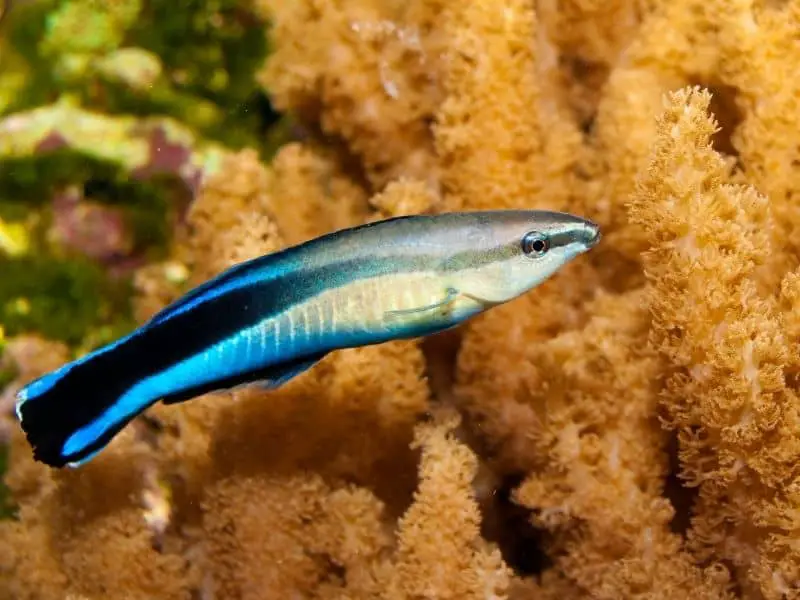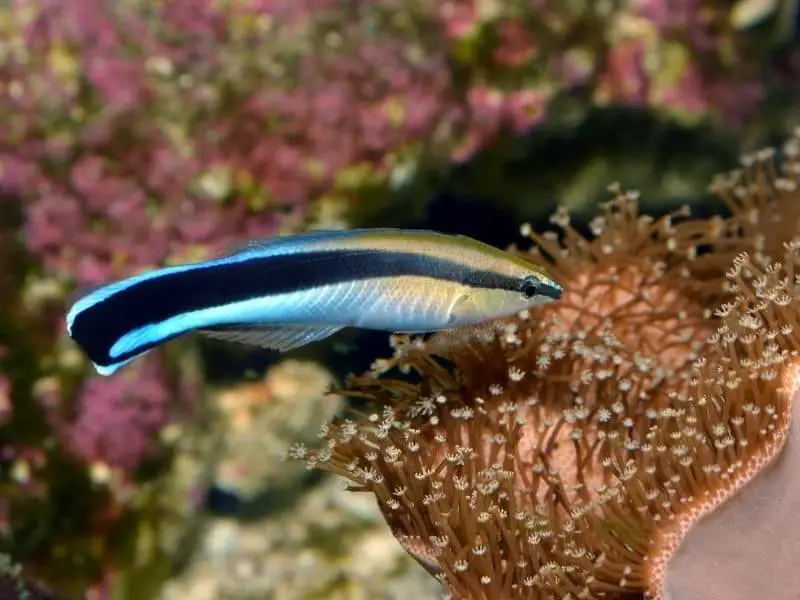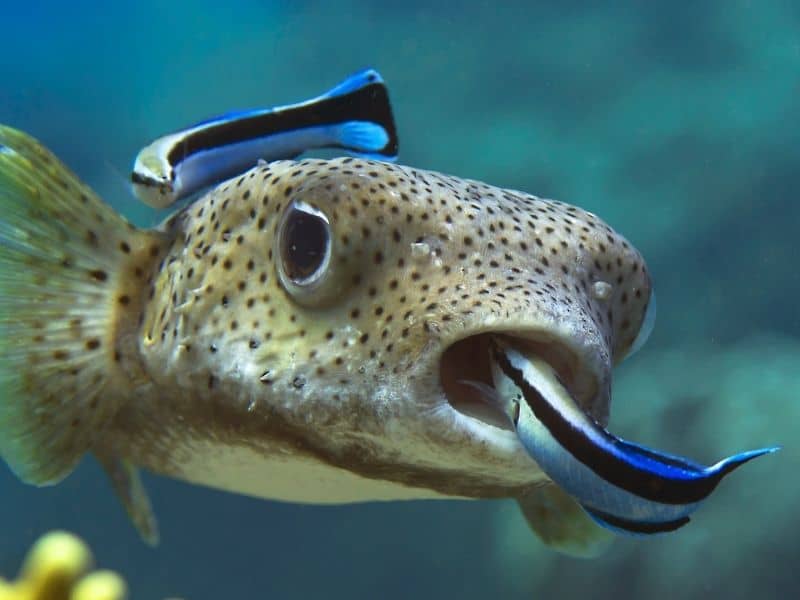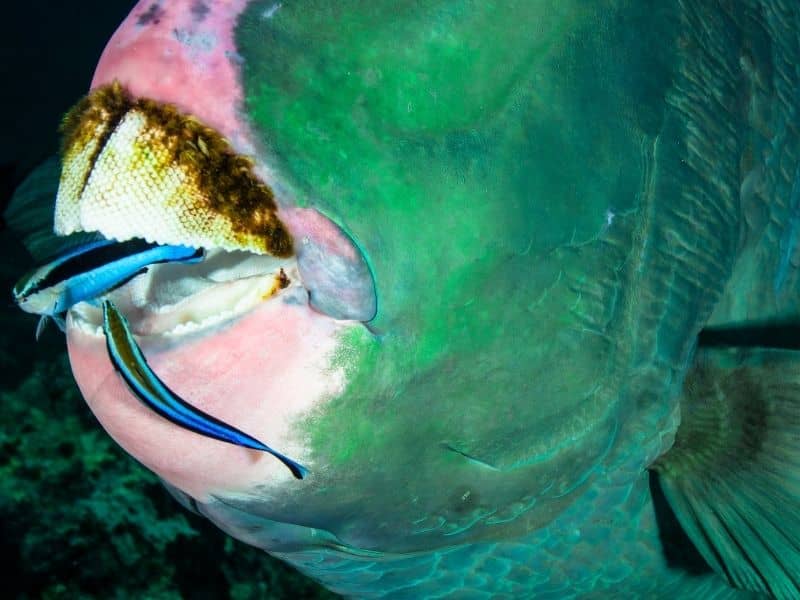Do you know a fish that can enter the larger fish’s gills and mouth without being eaten? There is one fish I know of having that ability and they are known as a Cleaner weasse. They are tiny saltwater fish that can eat dead tissues of other fish. Let’s look at more details about cleaner wrasse care.

One Look Care Guide
Jump To
- 1 One Look Care Guide
- 2 More about them
- 3 Interesting Facts About Cleaner Wrasse
- 4 Cleaner Wrasse Natural Habitat
- 5 Cleaner Wrasse Appearance
- 6 Cleaner Wrasse Colors And Types
- 7 Tank Requirements
- 8 How To Place Them In A Tank?
- 9 How To Acclimate Cleaner Wrasse Fish
- 10 Tank Mates Of Cleaner Wrasse
- 11 How Cleaner Wrasse Reproduce
- 12 What Does Cleaner Wrasse Eat?
- 13 Diseases Of Cleaner Wrasse
- 14 Predators Of Cleaner Wrasse
- 15 Cleaner Wrasse Mutualism
- 16 FAQ
- 17 Source
| Scientific name | Labroides dimidiatus |
| Common name | Blue streak cleaner wrasse, common cleaner wrasse & striped cleaner wrasse. |
| Care Level | Expert |
| Reef Compatible | Reef safe |
| Native to | Most wrasses inhabit the tropical and subtropical waters of the Atlantic, Indian and Pacific Oceans Commonly found in Africa, Indonesia and Maldives |
| Color | Black, Blue, White, yellow |
| Tank size | Minimum 55 gallon (110 gallons recommended) |
| Preferred temperature | 72-78° F |
| Preferred hardness | 8-12 dKH |
| Preferred pH | 8.1-8.4 |
| Other water parameters | Ammonia – 0 ppm Nitrate – 0 ppm Nitrite -0 ppm |
| Preferred salinity | 1.023-1.025 specific gravity (35ppt) |
| Size | 3-6 inch |
| Temperament | Peaceful |
| Recommended tank mates | Reef fish Damselfish Tangs Large Angels Large wrasses Sea Horses Pipefish Mandarins Sea Anemones |
| Diet | Carnivore |
| Preferred food | dead tissue and scales, mucus and ectoparasite |
| Feeding frequency | 3,4 times per day (if they eat supplement foods) |
| Propagation by | Sexual – External fertilization of eggs |
More about them
They are the tropical fish variety that has amazing and unique color patterns. They have 5 unique species. Among them, a Blue streak wrasse is the most popular variety. All these five varieties are associated with the coral area of tropical seas.
They generally live as a pair or a group of fish. Wrasse got this name due to their exciting feeding behavior. They mainly depend on dead skins and dead scales. Further, they eat ectoparasites that live on the fish body.
Interesting Facts About Cleaner Wrasse
- The most shocking factor is that they can enter the mouth of large predatory fish. They search for parasites in the large fish’s mouths and eat them.
- Not only the mouth, but they can also enter into the gill areas of larger fish to eat dead tissues and ectoparasites.
- Wrasse is commonly available in pet stores and they are inexpensive.
- Moreover, the blue streak wrasse is ideal for a community saltwater tank.
- Because of their reef-safe behavior, they suit reef saltwater tanks.
- But keep in mind this tiny fish is difficult to adjust to a new environment immediately. Thus, you have to acclimate them before adding them to the main tank.
- This small and beautiful creature lives for around 4 years in its natural environment.
Further, you need to have good knowledge of the wrasse to rear in the aquarium. This guide supports you to rear and care wrasse with good practices.
Want to learn more about wrasse fish? Check out our comprehensive guide to these fascinating creatures!” – wrasse fish
Cleaner Wrasse Natural Habitat
Most wrasses inhabit tropical and subtropical waters. They are commonly found in;
- Pacific Ocean
- Indian Ocean
- Atlantic Ocean
- Red sea
Africa, Indonesia, and the Maldives are the popular stations.
Cleaner Wrasse Appearance
The most common type is Blue streak cleaner wrasse. They have long, slender bodies and pointed noses. You can easily identify them by observing their color patterns. Their black strips start from the snout and end at the edge of the caudal fin. The Blue streak’s dorsal side is light blue and the belly side is white or slightly yellowish. They can change this white area into a light blue color in front of another animal.
Additionally, they are an active swimmer. They can grow around 3.5 inches to 6 inches long in the wild. The major important feature is their protruding teeth. Those teeth are like tweezers and help them to pluck dead tissues and parasites from the other fish’s bodies. They are hardy little fish and prone to diseases. The Blue streak wrasse gives a pleasant look to your saltwater aquarium. Their swimming behaviors give a fascinating look to your aquarium.

Cleaner Wrasse Colors And Types
They has five unique species.
| Blue streak Cleaner wrasse | Labroides dimidiatus | They can be identified by wide longitudinal black stripes running along the side and eye; the back and the stomach are white (sometimes slightly yellowish). |
| Black spot Cleaner wrasse | Labroides pectoralis | They have a yellow head and a bold black spot situated near the belly area. The black color stripe runs laterally and it starts from the snout and ends at the fish caudal fin. This strip fades at the posterior side of the fish body |
| Hawaiian Cleaner Wrasse | Labroides phthirophagus | The anterior part of the body of this fish is golden in color and dark lateral stripe running from the eye to the caudal fin. This strip is wider in the posterior part of the body. The purple and violet coloration can be seen on their fins. |
| Bicolor Cleaner Wrasse | Labroides bicolor | Has a beautiful bicolor appearance. Their body is bluish-gray color and a dark blue lateral stripe is present in the anterior part of the body. |
| Red Lip Cleaner Wrasse | Labroides rubrolabiatus | The male and female Red lip cleaner wrasses have a darkish strip that starts from the snout and fades into dark yellow at the posterior side. The caudal fin is black color. Red lip cleaner wrasses upper and lower lobes edges are white. |
Tank Requirements
They are ideal for a community saltwater tank. Because they love to live with other saltwater varieties. Further, they need a large space to swim. Hence you should have a large tank to rear them.

Size Of The Tank
The recommended tank size is 110 gallons. If you can provide larger than more than 110 gallons, it is better. The wrasse is an active swimmer and they love their swimming space.
Important tip: Do not select a small tank
Because their diet highly depends on the amount of fish available in the tank. You cannot add much fish into the small tank and it will cause a deficiency of food for them. Try to take a big tank as much as possible. Then you can add a huge amount of saltwater fish into it. The Cleaner wrasse can live healthily and happily in the large tanks.
Water Quality
They do not need any special tank conditions. The traditional reef aquarium water parameters are ideal for them. wrasse is a relatively hardy fish.
| Temperature | 72-78° F | Digital thermometer |
| Hardness | 8-12 dKH | Dip tests by |
| pH | 8.1-8.4 | Digital pH meter |
| Salinity | 1.023-1.025 specific gravity ( or 35 ppt) | Hydrometer/refractometer |
Tips: How to prepare salt water solution at home
You can prepare a 35 ppt salt water solution at home. Clean fresh water and aquarium salt are the major components that you need.
- Add 35 grams of aquarium salt to one liter of water and mix it properly.
- Check the salinity of the prepared solution using a refractometer or Hydrometer.
Substrates
Please add sandy substrates to the tank bottom. Because Cleaner wrasse buries themselves in a sand bed at the night time. Additionally, they also spend their nighttime in the cavity of the coral reef. They also like to live on rocks. Because Cleaner wrasses use these places as their hiding grounds and cleaning stations.
Flow rate
They do not need any specific flow rate. Anyhow you can use a good filter system to maintain water quality in your reef aquarium.
Lighting
They do not have any special lighting requirements. They can live healthily and happily under the lighting conditions of your reef aquarium. You can use:
- LED lights
- Kessil Tuna Blue A80 lights
- T5 lighting
Tank Roof
- This fish spent and enjoyed all layers of water columns. They never stay in a certain area for a long period.
- Moreover, they are well known to jump.
- Hence your reef aquarium should be covered with a proper roof cover.
How To Place Them In A Tank?
Do not add Cleaner wrasse directly to your main aquarium. First, you should quarantine them in a separate tank. Because marine fish contain lots of parasites and other disease-causing agents. During the quarantine period, you must pay high attention to the wrasse. Because they do not eat formulated stuff or any other live or frozen foodstuff. First, you should acclimate them before introducing them to the new environment. You can use;
- Floating bag method
- Drip method
I recommend doing the floating method along with the drip method.
How To Acclimate Cleaner Wrasse Fish
- Take a bucket and add 35 ppt (1.023-1.025 specific gravity) saline water to it.
- Float the fish bag on that water for 20-30 minutes
- Then water temperature of the bag same as the water in the bucket
- Then allow fish to enter that water
- Take the oxygen pipe and put one end to the main tank and another end to the bucket
- Suck water from the main tank and regulate the water passing rate
- The water passing rate should be 3 drips per second
- Acclimate fish for 30 minutes
- This drip method help to adapt the fish for tank water, then they can perform well
- After one hour you can catch them using the net and place them into a quarantine tank
- The quarantine tank should fill with the water of the main tank
Tank Mates Of Cleaner Wrasse
They are nonaggressive and reef-safe species. You can add them to your reef water aquarium. Do not add small fish varieties with wrasse fish. Because these small fish can disturb your wrasse when they try to clean the tank.

The suitable tank mates for Cleaner wrasses fish are;
- Gobies
- Dartfish
- Assessors
- Fairy wrasses
- Clownfish
- Dwarf angles
- Anthias
- Dotty backs
- Damselfish
- Tangs
- Large Angels
- Large wrasses
- Sea Horses
- Pipefish
- Mandarins
- Sea Anemones
How Cleaner Wrasse Reproduce
Male And Female Identification
It is difficult to distinguish males and females by observing their physical appearance. But if you take the same age fish, the male fish is larger than the female fish. Important facts about their gender
- They are hermaphroditic. It means every wrasse has male and female sex organs.
- When the male fish is not present, the dominant female can change their gender to male within 24 hours.
- Then he can mate with female fish.
- Usually, this gender transformation will happen before the fish turns 3 years old.
How Cleaner Wrasse Mate
Breed them in captivity is a bit difficult. Because most of the experiments are failed in captivity and rarely succeed in some breeds.
Interesting Facts About Cleaner Wrasse Breeding Process
- They breed one time per year
- Male starts mating dance to attract the sexually matured female wrasse.
- Females will stimulate and lay eggs. Then male wrasse will fertilize those eggs.
- Wrasse show external fertilization.
- Male wrasse breed with multiple females at a time.
- The spawning activities commonly happen in the afternoon hours of the day.
- The fertilized egg hatches within a few days
- The planktonic larvae are released into the water column.
- In the wild, planktonic larvae move with water currents.
What Does Cleaner Wrasse Eat?
The wrasse is a carnivore, and they are fast eaters. They have a symbiotic relationship with the fish in your tank. They mainly prefers to eat fish’s
- Dead skins
- Dead scale
- Mucus
- Ectoparasites
Moreover, they will eat parasites that are present in the tank too. Thus, you need to ensure that your tank has enough fish. Then they can fulfill their dietary requirement from that fish.

Do they Eat Fish Food?
Some aquarists try to give them prepared food such as;
- Frozen foods
- Live foods
- Pellets
- Flakes
Some formulated foods are accepted by Cleaner wrasses. But most of the Cleaner wrasses do not adapt to the prepared food. But you can try the following food types. There is a possibility to adapt them for that stuff when they fully adapt to the tank. Here I mentioned several successful food types for Cleaner wrasses in captivity. Meaty foods such as;
- Chopped shrimp, squid meat
- Clams
- Chopped beef heart
- Frozen brine shrimp
Starvation
If the tank has not had enough food, its life is in a threatened state. Because they are difficult to acclimate to traditional formulated food. Most of the poor Cleaner wrasses tend to die because of starvation. Thus, you should pay much attention to them and properly care for them. Thus, make sure to add Cleaner wrasses into the community tank that has enough fish. Then they can survive by eating fish debris.
How to feed them?
There is no special method to feed the Cleaner wrasse. Because they obtain their food by themselves. The only thing that you can do is add enough fish into their saltwater environment. Then they can eat those fish’s detritus.
Feeding frequency
Most cleaner wrasses do not rely on formulated foods. Thus, one need not worry about their diet. They will eat dead fish tissues and scales when they want.
- Cleaner wrasses are small fish with slender bodies. Hence, they are unable to store food like other fish varieties. Therefore they need to eat throughout the 24 hours of the day.
- According to the research studies, aquarists found that Cleaner wrasse can consume around 1200 parasites from 2300 fish within 4 hours.
- Their fast swimming behavior helps them to achieve enough food within a short time.
Diseases Of Cleaner Wrasse
- They are hardy fish and has a strong immune system.
- They have huge tolerance against the disease-causing agent.
- Furthermore, they can eat parasites that live in other fish’s mouths, skin, and gills.
Predators Of Cleaner Wrasse
They show mutualisms with predatory fish. In nature, predatory fish are carnivores and have large bodies. But they do not harm the wrasse. When they need cleaner wrasse’s service, they come to cleaner stations and clean their bodies.
Interesting Factors
- Cleaner wrasses are entered even into the predatory fish’s mouth to clean parasites.
- However, these large fish do not tend to eat them.
But Following species show some predatory behaviors against them.
- Lionfish
- Groupers
- Soap fish
Cleaner Wrasse Mutualism
The relationship between two fish is called mutualism. Cleaner wrasse and reef fish are the popular varieties that show mutualism. In this partnership both parties got benefits. As an example wrasse eat dead cells and parasites that live on the body of reef fish. The reef fish gain benefit by removing parasites and dead tissues from their body.
FAQ
Are Cleaner Wrasses Hard To Keep?
Yes, they are fast eaters and they highly depend on fish debris and parasites. In the natural environment, they can obtain plenty of parasites within a short period. They can eat 1200 parasites that are present in 2300 fishes within four hours. But the tank environment is free from parasites.
Further, it is impossible to rear hundreds of fish in the home aquarium. Therefore Blue streak cleaner wrasses fish unable to fulfill their nutrient requirement in captivity. Moreover, they do not like to eat formulated, live, frozen and freeze-dried fish food. Because of the above reasons, they are starving in captivity. Then they tend to die.
Do they Eat Algae?
No. Blue streak cleaner wrasses is a carnivore. Thus they only rely on animal matters such as;
- Skin debris
- Scales
- Parasites
- Fish mucus
Thus, they do not eat plant matter and algae.
Can I Keep Two Cleaner Wrasses Together?
Male cleaner wrasses show aggression to other male cleaner wrasses. Thus, you should keep one male cleaner wrasses fish in a tank. Then that male can be paired with one or multiple female cleaner wrasses fish.
Important: Cleaner wrasses are sequential hermaphrodites
- It means every fish has both male and female reproductive organs.
- Because of this special feature, they can change their gender in a special situation.
- As an example, if male cleaner wrasses die in a group, the most dominant female becomes the male fish.
Cleaner wrasses also show aggressive behavior for other species such as Melanurus wrasses.
Source
Bshary, R., 2003. The c wrasse, Labroides dimidiatus, is a key organism for reef fish diversity at Ras Mohammed National Park, Egypt. Journal of Animal Ecology, 72(1), pp.169-176.
Related
Spotted Wrasse Care ( Look How Adorable They Are! )
Sixline Wrasse Fish | Care Guide For Amazing Fish |
